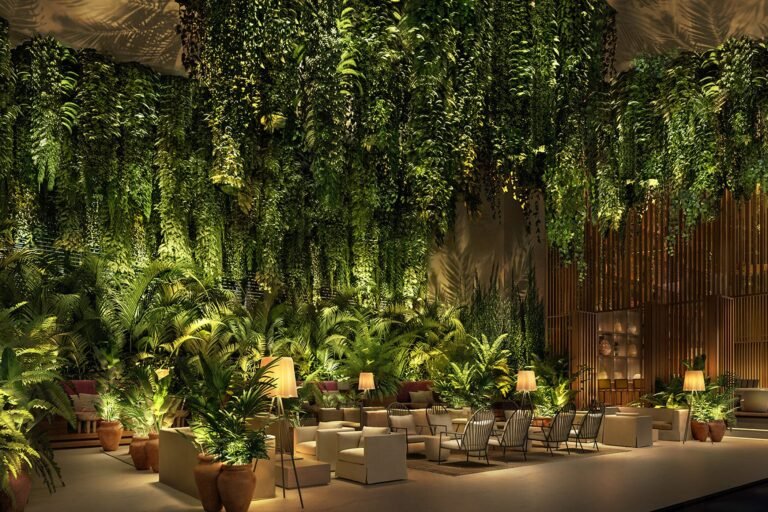Wellness has emerged as a fundamental part of the travel experience, a top priority for guests of all levels and no longer just a perk of luxury hotels and resorts.
But wellness is no longer just about spa treatments and healthy menu options. Today’s wellness trends include self-care, quality sleep, personal and environmental connection, social responsibility, and sustainability, says Ana Ramirez, co-founder and wellness hospitality designer at Ancestral Handmade Hotels. He said there is a built-in possibility. Mr. Ramirez led a panel discussion on this topic at the recent SAHIC Latin American and Caribbean Conference.
Hoteliers can implement wellness elements at many levels through programming, design, architecture, and even technology. Both small and large-scale efforts are attractive, speakers said.
Ramirez identified eight key wellness trends that will impact travel now and in the future.
1. Climate-adapted wellness design: “Thinking about cooling architecture, high performance [buildings] There are also structures with shade,” Ramirez said. The trend recognizes that people, buildings and technology work harder in the heat, and encourages elements such as evening and evening programs, shaded structures and rooftop gardens.
2. A highly personalized wellness resort and longevity hub: “We want the wisdom of age and the biology of youth,” Ramirez said. This means medical spas that offer rejuvenating treatments and other options such as menu items that promote longevity.
3. Sensory hacking and multisensory immersive design: Whole body health means engaging all five senses, Ramirez said. Hotels and resorts exploring this trend combine technology and physical elements, such as immersive art installations, to stimulate all the senses.
4. Holistic connection and self-care: Ramirez said that while some early definitions of wellness suggested isolation, many travelers now recognize the value of connection and plan trips with other people. “People are looking for their tribe,” she said. “Events focusing on menopause treatment, culinary adventures, grief and other elements continue to grow.”
5. Biocompatible design: Bringing the outside in is a pillar of hotel interior design, and Ramirez foresees a design that is even more connected to the earth. She cited golf courses that encourage players to go barefoot.
6. Renewable hospitality and community: Ramirez said travelers are seeking more information about local communities and resources when they travel and want to ensure tourism is renewable, a trend that takes sustainability a step further. He said it is in progress. “Designs that embrace nature, architecture using locally found materials, and programs that blend ancient healing with modern practices transform stays and empower people to get more. ” she said.
7. Sports and Hospitality: Fitness is also a strong area of wellness, and Ramirez said fitness is now extending to recovery as well. In addition to professional-grade training equipment, guests want recovery amenities such as sleep aids (including high-tech mattresses, high-quality sheets, and white noise), vitamin drips, and cool-down tools.
8. Technology Health: Ramirez predicts that technology- and artificial intelligence-based programs that people use at home, such as Peloton and Technogym machines that track progress, will become more popular in hotels. “These are powered by digital health services that provide health monitoring and diagnosis,” she said.
Hoteliers increasingly feel a long-term responsibility to incorporate wellness elements into hotel and resort projects. The main reason for this is that many of our practices are linked to sustainability.
“Wellness is here to stay, and as planners, architects and designers, we have a responsibility,” said EDSA Principal Marco Larrea. “When we do a master plan, we don’t say, ‘Let’s build 20 houses here and a golf course there.’ We’re looking at a comprehensive plan for the environment.”
Larrea said technology can go a long way. Architects and designers can assess and take measurements of the terrain before visiting the site, helping them plan more sustainably.
Another tactic is to be creative with what you have at hand, Larrea said. He talked about a hotel project in La Paz, Mexico. It included an old farmhouse. Rather than tear it down, the designers worked with the owners to create a wellness hub with a farm-to-table restaurant inside the farmhouse.
“We placed all the equipment properly and maintained 80 percent of the natural topography,” he said.
Emilio Perez, Marriott International’s senior continental leader for global design for the Caribbean and South America, said wellness elements that connect with local communities resonate strongly with hotel and resort owners.
“The social element is very important to owners,” he says. “The social impact that our work creates in the communities we work in is a pillar of our design process.”
Guilherme Cesari, Accor’s vice president of development, luxury and lifestyle, agrees.
“The owners of the resorts we are currently developing want restaurants that partner with local vendors,” he said. “We offer unprocessed, highly natural and healthy food, while also providing our guests with an opportunity to connect with their local community, an important aspect of health.”
And yes, the spa maintains its popular status as the hotel’s wellness hub, speakers said.
“Wellness at a spa means activities that help you connect with yourself,” says Cesari. “Meditation, yoga, hiking, and other activities that you do for yourself, so you need the equipment to provide those things.”
Read more news on Hotel News Now.


